Dear Aspirants, Our IBPS Guide team is providing new series of Reasoning Questions for IBPS RRB Clerk Prelims 2019 so the aspirants can practice it on a daily basis. These questions are framed by our skilled experts after understanding your needs thoroughly. Aspirants can practice these new series questions daily to familiarize with the exact exam pattern and make your preparation effective.
Check here for IBPS RRB Clerk Prelims Mock Test 2019
[WpProQuiz 6499]
Directions (1 – 5): Study the following information carefully and answer the below questions.
Seven friends namely P, Q, R, S, T, U and V travelled seven different places namely Delhi, Bangalore, Chennai, Mumbai, Ooty, Pune and Shimla but not necessarily in the same order starting from Monday to Sunday.
T travelled on Thursday. Only one person travelled between T and the one who travelled to Pune. P travelled immediately after the one who travelled to Pune. Only three people travelled between P and the one who travelled to Bangalore. Only two people travelled between the one who travelled to Bangalore and U. The one who travelled to Mumbai travelled before U but after Thursday. More than two people travelled between Mumbai and R. The one who goes to Shimla travelled immediately before the one who travelled to Delhi. The one who travelled to Chennai travelled immediately before Q.V does not travel on Tuesday.
1) Who among the following travels to Ooty?
a) U
b) P
c) Q
d) T
e) V
2) Four of the following five are alike in a certain way and so form a group. Which of the following does not belong to that group?
a) Q – Sunday
b) P – Friday
c) U – Saturday
d) S – Thursday
e) T – Tuesday
3) On which of the following days does Q travel?
a) Wednesday
b) Thursday
c) Saturday
d) Friday
e) Sunday
4) To which of the following place does V travels?
a) Delhi
b) Shimla
c) Bangalore
d) Mumbai
e) Ooty
5) Which of the following combination is true regarding Sunday?
a) U – Pune
b) Q – Mumbai
c) R – Shimla
d) P – Ooty
e) S – Delhi
Directions (6 – 10): Study the following information carefully and answer the below questions.
Certain numbers of the people are seated in a straight line facing north. A sits fifth to the left of B. Two persons are sitting B and C. The number of persons between B and D is two more than the number of persons between C and A. Four people sits between E and B. D sits at the extreme left of the line and is not to the right of B. Three persons sit between E and F. F does not sit at the extreme end of the line.
6) How many people are seated in a line?
a) 15
b) 16
c) 17
d) 18
e) 19
7) What will be the position of F with respect to B?
a) Immediate Right
b) Immediate Left
c) Second Right
d) Second Left
e) None of these
8) If one person sit between E and H, then total how many person are possible in the line?
a) 16
b) 17
c) 18
d) 19
e) 20
9) Who among the following sits exactly between F and E?
a) A
b) B
c) C
d) D
e) None
10) How many person sit between A and D?
a) None
b) One
c) Two
d) Three
e) More than three
Answers :
Directions (1-5):
- T travelled on Thursday. Only one person travelled between T and the one who travelled to Pune.
- From the above statement, we get case (1) and case (2).

- P travelled immediately after the one who travelled to Pune.
- Only three people travelled between P and the one who travelled to Bangalore.
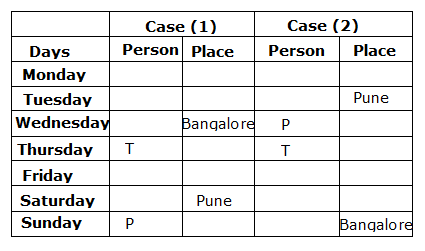
- Only two people travelled between the one who travelled to Bangalore and U.
- From the above statement, case 2 gets eliminated.
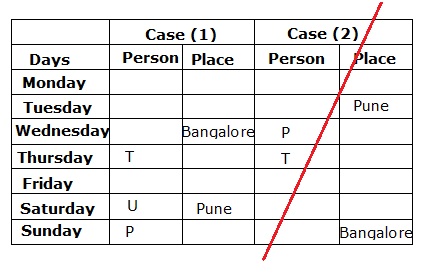
- The one who travelled to Mumbai travelled before U but after Thursday.
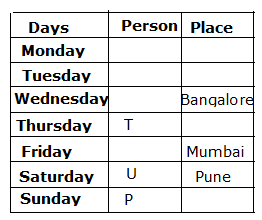
- More than two people travelled between Mumbai and R. The one who travelled to Shimla immediately before the one who travelled to Delhi.

- The one who travelled to Chennai travelled immediately before Q.

- V does not travel on Tuesday.
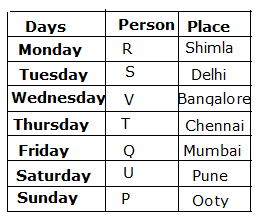
1) Answer: B
2) Answer: C
3) Answer: D
4) Answer: C
5) Answer: D
Directions (6-10):
- A sits fifth to the left of B. Two person are sitting B and C.
From the above statement we get two possibilities Case (1) and Case (2),
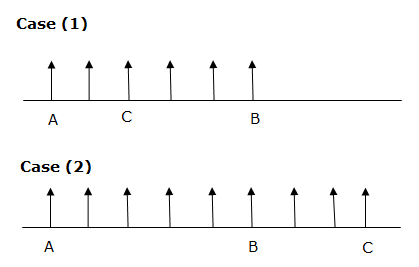
- The number of persons between B and D is two more than the number of persons between C and A. D sits at the extreme left of the line and is not to the right of B.
From the above statement, case 1 gets eliminated, as D does not sits in the extreme end of the line.
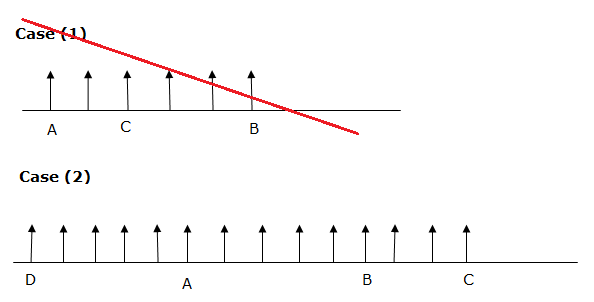
- Four person sits between E and B.

- Three person sit between E and F.F does not sit at the extreme end of the line.

16 person are seated in the line.
6) Answer: B
7) Answer: A
8) Answer: C
9) Answer: C
10) Answer: E





